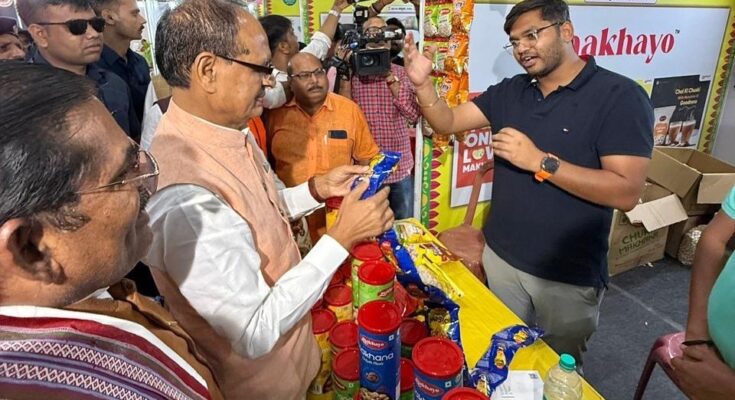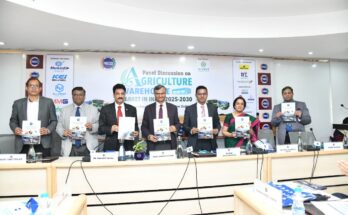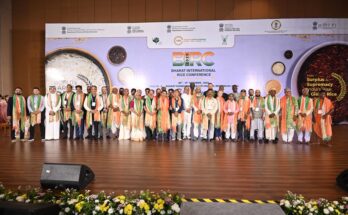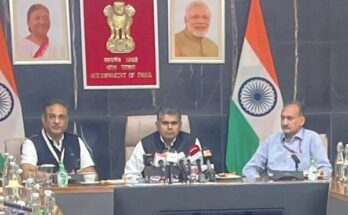By BK Jha, Patna
In the broad lawns of Gyan Bhavan, flanking Gandhi Maidan, the annual Makhana Mahotsav unfolded today under a glittering array of banners and footfalls. The visit of Union Agriculture Minister Shivraj Singh Chouhan was the principal draw, but the festival brought into sharper relief the complex realities behind Bihar’s makhana (fox nut) economy—its promise, its pressures, and its people.
The focal moment came when Minister Chouhan released a new report titled “Makhana: From Culture to Prosperity” (Makhana: Sanskriti se Samriddhi). Addressing a mixed audience of farmers, scientists, exporters and bureaucrats, he described makhana as an “extraordinary blessing” for the underprivileged and hailed Bihar as a global hub for its production. He underlined that the state was witnessing prosperity through agriculture and reminded the gathering that “farmers are the soul of India’s economy.” The Minister pointed out that cultivation area, which earlier covered around 3,000 hectares, has now expanded to 35,000–40,000 hectares.
Chouhan announced that the Central Government has notified the establishment of a Makhana Board to promote research, development, marketing, branding, and promotion of makhana. He added that nearly ₹475 crore has been sanctioned for modern machinery, new variety development, and processing facilities to boost makhana production and value addition.
Earlier, at the Rabi Workshop and Agricultural Advisory Dialogue in Patna, he had also referred to India’s agricultural transformation, from the days of importing red wheat under PL-480 to now being self-sufficient and even capable of exporting food grains. He reiterated the government’s commitment to stabilizing minimum support prices and boosting productivity in districts like those in Bihar through the Pradhan Mantri Dhan-Dhaanya Krishi Yojana.
Yet beyond the assurances, the Mahotsav reminded observers that makhana’s ascent is far from problem-free. Makhana, or Euryale ferox, is an aquatic crop whose seeds are harvested from ponds, oxbow lakes, and wetlands. Its cultivation is concentrated in stagnant water bodies rather than tilled fields, and Bihar contributes nearly 90 percent of India’s output. Districts such as Madhubani, Darbhanga, Katihar, Purnia, Saharsa, Sitamarhi and Araria form the backbone of production. The celebrated Mithila Makhana variety holds a Geographical Indication (GI) tag, a mark of pride as well as a branding opportunity.
The commercial potential is significant. India’s makhana market, estimated at ₹8.5 billion in 2024, is projected to grow annually by over nine percent, while some reports place the figure much higher, suggesting a robust expansion in the coming decade. But alongside opportunity, there is fragility. Producing edible makhana is a labor-intensive and delicate process. Seeds must be collected from underwater, painstakingly dried, roasted, and popped. Only a fraction of the original seed weight emerges as edible white kernels. For generations, women—often fisherwomen—have carried out this work, yet many are compelled to sell early at discounted rates because they cannot afford to hold their stocks.
The appeal of makhana lies in both culture and health. Once considered a fasting food in Mithila and other parts of India, it has now become a global “superfood,” celebrated for being low in calories, gluten-free, and rich in minerals like calcium, magnesium and potassium. Health experts highlight that a small cup of makhana offers useful protein and essential nutrients, and urban consumers increasingly prefer it as a healthy snack alternative. At the same time, nutritionists caution that over-consumption may not be advisable for everyone, particularly those with certain medical conditions.
Climate change is another shadow looming over this fragile ecosystem. Erratic rainfall, rising temperatures and shrinking water bodies are already challenging farmers. Reports have highlighted how rivers dried up early in 2024, leaving ponds stressed and making makhana cultivation precarious. Without effective watershed management, wetland rejuvenation and reliable water releases, the very base of the makhana economy could come under threat.
At the Mahotsav itself, amid the ministerial speeches, one could sense both hope and unease. Entrepreneurs showcased value-added products such as powdered makhana blends, flavored snacks and ready-to-eat varieties that could expand markets and margins. Research institutions underlined plans for new varieties like “Sabour Makhana-1,” designed for organic cultivation. Proposals for a National Makhana Board headquartered in Bihar also added to the institutional buzz. Yet farmers quietly pointed to transport bottlenecks, lack of mechanization, storage shortfalls and dependence on middlemen that continue to erode their profits.
What emerges is a paradox. Bihar’s makhana has both a global market pull and deep local roots, yet it stands vulnerable to climatic uncertainty, fragile infrastructure, and financial inequity. Real progress will demand more than festivals and slogans. It requires investments in mechanization, storage and processing units; improved access to credit and crop insurance; stronger branding of Mithila Makhana for export markets; and policies that include women workers as equal stakeholders in this economy.
The Makhana Mahotsav of 2025 succeeded in drawing attention and energy, and the optimism on stage was palpable. But the true test lies beyond Gyan Bhavan. If the government, researchers, and industry can convert today’s rhetoric into tomorrow’s reality, then makhana may indeed serve as both Bihar’s pride and India’s gift to the world. Until then, the story of this aquatic seed will continue to be written in the rhythms of pond and pop, of culture and commerce, of promise and persistence.




